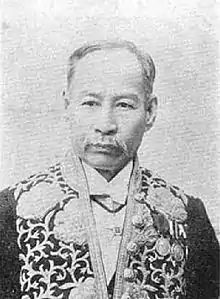Kim Ga-jin 김가진 金嘉鎭 | |
|---|---|
 Portrait of Kim Ga-jin | |
| Minister of Agriculture, Industry and Commerce | |
| In office 1 April 1895 (Lunar) – 17 August 1895 (Lunar) | |
| Monarch | Gojong of Korea |
| Preceded by | Formation |
| Succeeded by | Yi Bum-jin |
| Minister of Agriculture, Industry and Commerce | |
| In office 8 March 1904 – 8 March 1904 | |
| Monarch | Gojong of Korea |
| Preceded by | Shim Sang-hun |
| Succeeded by | Yi Geun-myeong |
| Minister of Justice | |
| In office 15 September 1904 – ? | |
| Monarch | Gojong of Korea |
| Preceded by | Pak Chesoon |
| Succeeded by | Gwon Jung-hyeon |
| Personal details | |
| Born | 1846 |
| Died | 4 July 1923 (aged 76–77) Shanghai, Republic of China |
| Nationality | Korean |
| Occupation | Korean politician |
| Kim Ga-jin | |
| Hangul | |
|---|---|
| Hanja | |
| Revised Romanization | Kim Ga-jin |
| McCune–Reischauer | Kim Kachin |
| Courtesy name | |
| Hangul | |
| Hanja | |
| Revised Romanization | Dongnong |
| McCune–Reischauer | Tongnong |
Kim Ga-jin (Korean: 김가진; 1846 – 4 July 1923) was an Imperial Korean politician, diplomat and an independence activist during Korea under Japanese rule.
Life
Kim was born in 1846. His father was Kim Ung-gyun, who was a member of Andong Kim clan. His father was a Yejo Minister.[1] He was a concubine child from a Kisaeng.[2] He started his career as Chamseogwan of Royal library. In 1886, Kim passed Gwageo literary examination.[1] On 16 May 1887 (Lunar Calendar), Kim was appointed as minister sent to Tokyo.[3] He was sent back to Korea on 21 September 1891 (Lunar Calendar).[4]
Kim was a great supporter of reform. Kim tried to eliminate Yeoheung Min clan from the power and bring Heungseon Daewongun to power.[5] Daewongun also wanted to use Kim in the new government as a member of progressive fraction.[6] Kim was appointed as Minister of agriculture, Industry and Commerce on 1 April 1895 (Lunar Calendar).[7] Kim resigned his position on 17 August 1895 (Lunar Calendar).[8][9] In August 1895, Kim was appointed as 1st Class member of Junchuwon.[10] On 27 August 1895, Kim was appointed as the Korean envoy sent to Japan.[11] Kim resigned from his office on 1 February 1896.[12] He was appointed as 1st class member of the Junchuwon.[13] In July 1896, Kim registered in the newly formed Independence Club.[1]
Kim served the Korean Empire in various posts such as Speaker of the Jungchuwon, and Special Official of Gungnaebu. After the Japan–Korea Treaty of 1905 was signed, Kim showed his disapproval.[1] On 8 May 1906, Kim was demoted to the Observer of the South Chungcheong Province.[14] To fend off the Japanese colonization, Kim became the president of Daehan Organizations.[1] In 1907, he was appointed as Gyujanggak Jaehak[1] and retired from the officialdom same year.[15]
After the annexation of Korea, Kim was ennobled as Baron.[16] During the March 1st Movement, Kim participated as one of the representatives of Korea.[17] After the March 1st Movement, Kim became the president of Daedongdan.[18] On 19 October 1919, Kim fled to Shanghai with Yi Jong-uk, an agent from the Provisional Government of the Republic of Korea to Seoul.[19] Kim and Yi went to Shanghai by train. Kim disguised himself as a man living in countryside.[20] Kim's refuge was successful, helped the Daedongdan to act in Shanghai.[21] After Daedongdan was dissolved, Kim joined the Provisional Government of the Republic of Korea.[1] He died in Shanghai on 4 July 1922.[22]
Honors
- Order of the Palgwae 2nd Class on 11 April 1905[23]
Sources
- 1 2 3 4 5 6 7 "김가진(金嘉鎭) - 한국민족문화대백과사전". encykorea.aks.ac.kr. Retrieved 2022-07-20.
- ↑ Hwang, Hyeon. "19. 김가진의 내력". db.history.go.kr. Retrieved 2022-08-03.
- ↑ Veritable Records of the Joseon Dynasty. "민영준과 김가진을 일본에 파견할 공사로 임명하다". sillok.history.go.kr. Retrieved 2022-07-29.
- ↑ Veritable Research of Joseon Dynasty. "주차 일본 판사 대신 김가진을 소견하다". sillok.history.go.kr. Retrieved 2022-07-29.
- ↑ 신편한국사. "2) 제1차 개혁의 추진세력". db.history.go.kr. Retrieved 2022-07-29.
- ↑ Records of Japanese Legation in Korea. "(285) [大院君의 동정 통고]". db.history.go.kr. Retrieved 2022-08-03.
- ↑ 조선·대한제국 관보. "4月1日". db.history.go.kr. Retrieved 2022-07-20.
- ↑ 조선·대한제국 관보. "8月16日". db.history.go.kr. Retrieved 2022-07-20.
- ↑ 조선·대한제국 관보. "軍部大臣安駉壽辭職疏". db.history.go.kr. Retrieved 2022-07-20.
- ↑ 조선·대한제국 관보. "8月17日, 8月19日". db.history.go.kr. Retrieved 2022-07-20.
- ↑ 조선·대한제국 관보. "8月18日, 8月27日". db.history.go.kr. Retrieved 2022-07-20.
- ↑ 조선·대한제국 관보. "2月1日". db.history.go.kr. Retrieved 2022-07-20.
- ↑ Veritable Records of the Joseon Dynasty. "김가진을 중추원 1등의관에 임명하다".
- ↑ Veritable Records of the Joseon Dynasty. "김가진을 충청남도 관찰사에 임명하다". sillok.history.go.kr. Retrieved 2022-08-03.
- ↑ 유, 경선 (2022-10-27). "'임시정부 원로' 김가진, 독립유공 서훈 8번 보류···사망 100주기 맞아 "재평가" 목소리". m.khan.co.kr (in Korean). Retrieved 2023-02-15.
- ↑ 조선총독부 관보. "明治43年10月7日". db.history.go.kr. Retrieved 2022-08-03.
- ↑ 삼일운동 아카이브. "선언서". Retrieved 2022-08-05.
- ↑ 한민족독립운동사자료집. "崔益煥 신문조서(제3회)". Retrieved 2022-08-09.
- ↑ 일제침략하한국36년사. "大韓民國臨時政府 京城特派員 李鍾郁은 金嘉鎭을 同伴하고 上海로 歸還하다". Retrieved 2022-08-09.
{{cite web}}: CS1 maint: numeric names: authors list (link) - ↑ 한민족독립운동사자료집. "宋世浩 신문조서(제2회)". Retrieved 2022-08-09.
- ↑ "하루빨리 서훈·유해환국 나서야". www.hani.co.kr (in Korean). 2022-07-06. Retrieved 2022-08-09.
- ↑ 일제침략하한국36년사. "大同團 總裁 東農 金嘉鎭이 上海에". Retrieved 2022-08-06.
{{cite web}}: CS1 maint: numeric names: authors list (link) - ↑ Veritable Records of the Joseon Dynasty. "이재곤, 김승규, 민재설 등에게 훈장을 주다". sillok.history.go.kr. Retrieved 2022-08-03.